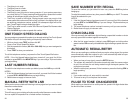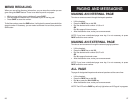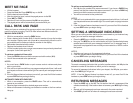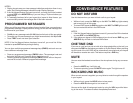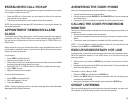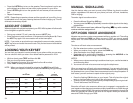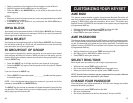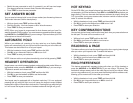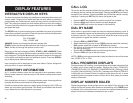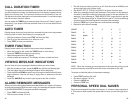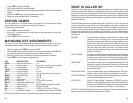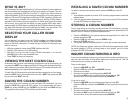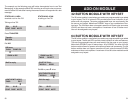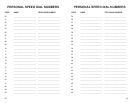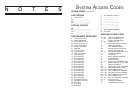48
NOTES:
1. If you are on an intercom call or you have Automatic Hold turned off, you
must finish the existing call or place it on hold before inquiring.
2. If you inquire about an outgoing call, you will receive a [call no longer avail-
able] display.
REVIEWING PAST CID/ANI CALLS
This feature allows you to review CID information for calls sent to your keyset.
This list can contain 10–50 calls in a last-in, first-out basis. The list includes
calls that you answered and calls that rang your keyset but that you did not
answer. When reviewing this list, you can press one button to dial the person
back. The system must be using LCR to dial the stored number. To access the
CID information stored in your REVIEW list:
• Press the REVIEW key, OR
Press the CID key and then press the REVIEW soft key.
• If you have entries in your review list, the most recent call will be shown first.
• You can now CLEAR this entry, OR
Use NND to view more information about this call, OR
Press DIAL to call this person back, OR
Press SCROLL and then press STORE to save this number in a personal
speed dial bin.
NOTES:
1. Each keyset defaults with ten review bins. Please see your system adminis-
trator to determine the number of bins assigned to your keyset.
2. Your system must have LCR correctly programmed to allow you to DIAL
numbers from the review list or to STORE entries from the review list.
LCR WITH CLEAR
When you are making an outside call using LCR and dial an incorrect digit, you
can press the CLEAR soft key to reenter the telephone number. You do not need
to redial 9 to reaccess LCR.
BACKSPACE WITH LCR
If you misdial while using LCR, you can delete digits shown in the display by
pressing the BSPC soft key as many times as necessary.
ADVANCED PROGRAMMED MESSAGES
This is an advanced form of the PROGRAMMED MESSAGE feature with the
ability to add an extender such as date or time. Example [RETURN ON:Dec/24]
or [RETURN AT:03:30p]. These are messages 26-30 and can be used in addi-
tion to 01-25 described in PAGING AND MESSAGING section in this guide.
• With the handset on-hook, press TRSF and then dial 115.
49
• Dial any message code (01-30) listed on the back of this user guide or press
UP or DOWN to select any message you desire. Messages 26-30 are used
for inserting a date or time. If you select one of these messages (26-30),
your phone will wait for five more digits to be entered. At this point you will
enter two digits for hour or month (01-23) and two digits for day or minutes
(00-59). The fifth and final digit to be entered is a ✱ located on your dial pad
to select “a” for A.M., “p” for P.M. or “/” for date. Depressing the ✱ button on
your dial pad will scroll through these three options (“a”, “p”, and “/”).
• Press TRSF to exit and store your selection.
To cancel any of these messages:
• With the handset on-hook, dial 48 plus 00, OR
• With the handset on-hook press TRSF and then dial 115 plus 00 and TRSF
again to exit.
TEXT MESSAGING
This feature allows two digital keyset users to respond to each other with
preprogrammed messages. After receiving an Off Hook Voice Announcement or
Station Camp-On, you may respond with a text message while continuing to
talk and listen to your outside party. The other station can view this message
and take the appropriate action or respond back with another text message.
There are 25 messages (01-25) stored in system memory that can be sent to
another display keyset. Only the display keysets that are allowed in system
programming (MMC 318) will receive the TMSG softkey in the display and use
this feature.
Familiarization with the two digit message numbers you will use the most will
make this procedure quick and easy. However if you do not know them, use the
UP/DOWN key to scroll to the desired message, then press SEND.
The basics steps in text messaging are:
1. Press TMSG soft key to begin text messaging.
2. Dial the 2 digit number for the desired message.
3. Confirm this is the intended message then press SEND.
4. Wait for a reply from the other station (steps 1, 2 & 3)
5. When any station presses EXIT the displays at both stations return to their
previous call progress condition.
At all times after step 1 you can talk and listen to your caller while repeating
steps 2.



